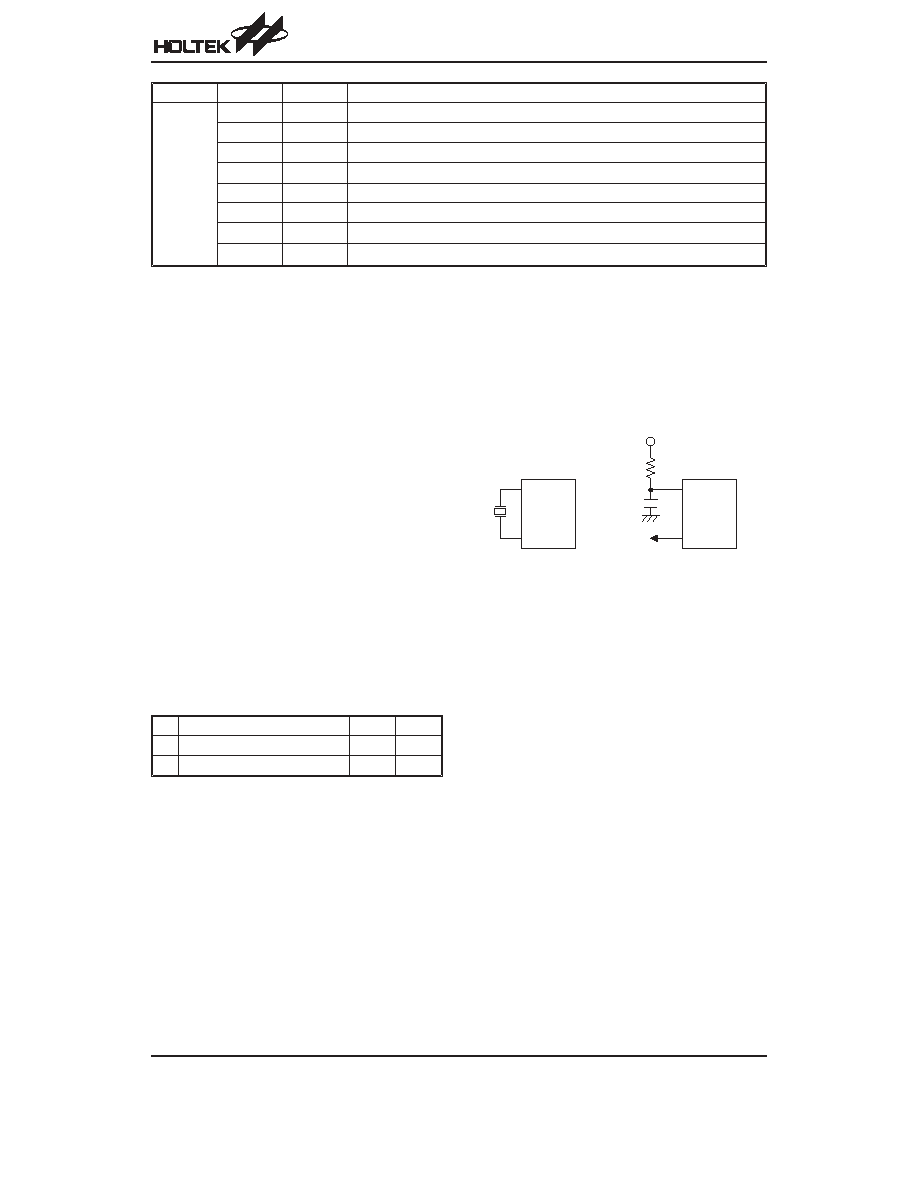- 您现在的位置:买卖IC网 > PDF目录33810 > 48e30 (Holtek Semiconductor Inc.) 8-Bit I/O Type MCU (With EEPROM) PDF资料下载
参数资料
| 型号: | 48e30 |
| 厂商: | Holtek Semiconductor Inc. |
| 英文描述: | 8-Bit I/O Type MCU (With EEPROM) |
| 中文描述: | 8位I / O型微控制器(带EEPROM) |
| 文件页数: | 2/44页 |
| 文件大小: | 351K |
| 代理商: | 48E30 |
第1页当前第2页第3页第4页第5页第6页第7页第8页第9页第10页第11页第12页第13页第14页第15页第16页第17页第18页第19页第20页第21页第22页第23页第24页第25页第26页第27页第28页第29页第30页第31页第32页第33页第34页第35页第36页第37页第38页第39页第40页第41页第42页第43页第44页

HT48E30
Rev. 0.00
10
January 12, 2004
Preliminary
subroutine call to location 04H will occur. The interrupt
request flag (EIF) and EMI bits will be cleared to disable
other interrupts.
The internal timer/event counter interrupt is initialized by
setting the timer/event counter interrupt request flag
(TF; bit 5 of INTC), caused by a timer overflow. When
the interrupt is enabled, the stack is not full and the TF
bit is set, a subroutine call to location 08H will occur. The
related interrupt request flag (TF) will be reset and the
EMI bit cleared to disable further interrupts.
During the execution of an interrupt subroutine, other in-
terrupt acknowledge signals are held until the
RETI in-
struction is executed or the EMI bit and the related
interrupt control bit are set to 1 (if the stack is not full). To
return from the interrupt subroutine,
RET or RETI
may be invoked. RETI will set the EMI bit to enable an in-
terrupt service, but RET will not.
Interrupts, occurring in the interval between the rising
edges of two consecutive T2 pulses, will be serviced on
the latter of the two T2 pulses, if the corresponding inter-
rupts are enabled. In the case of simultaneous requests
the following table shows the priority that is applied.
These can be masked by resetting the EMI bit.
No.
Interrupt Source
Priority Vector
a
External Interrupt
1
04H
b
Timer/Event Counter Overflow
2
08H
The timer/event counter interrupt request flag (TF), ex-
ternal interrupt request flag (EIF), enable timer/event
counter interrupt bit (ETI), enable external interrupt bit
(EEI) and enable master interrupt bit (EMI) constitute an
interrupt control register (INTC) which is located at 0BH
in the data memory. EMI, EEI, ETI are used to control
the enabling/disabling of interrupts. These bits prevent
the requested interrupt from being serviced. Once the
interrupt request flags (TF, EIF) are set, they will remain
in the INTC register until the interrupts are serviced or
cleared by a software instruction.
It is recommended that a program does not use the
CALL subroutine within the interrupt subroutine. In-
terrupts often occur in an unpredictable manner or
need to be serviced immediately in some applications.
If only one stack is left and enabling the interrupt is not
well controlled, the original control sequence will be dam-
aged once the
CALL operates in the interrupt subrou-
tine.
Oscillator Configuration
There are 2 oscillator circuits in the microcontroller.
All of them are designed for system clocks, namely, ex-
ternal RC oscillator and external Crystal oscillator,
which are determined by options. No matter what oscil-
lator type is selected, the signal provides the system
clock. The HALT mode stops the system oscillator and
ignores an external signal to conserve power.
If an RC oscillator is used, an external resistor between
OSC1 and VDD is required and the resistance must
range from 24k
W to 1MW. The system clock, divided by
4, is available on OSC2, which can be used to synchro-
nize external logic. The RC oscillator provides the most
cost effective solution. However, the frequency of oscil-
lation may vary with VDD, temperatures and the chip it-
self due to process variations. It is, therefore, not
suitable for timing sensitive operations where an accu-
rate oscillator frequency is desired.
If a Crystal oscillator is used, a crystal across OSC1 and
OSC2 is needed to provide the feedback and phase
shift required for the oscillator. No other external compo-
nents are required. In stead of a crystal, a resonator can
also be connected between OSC1 and OSC2 to obtain
a frequency reference, but two external capacitors in
OSC1 and OSC2 are required.
The WDT oscillator is a free running on-chip RC oscilla-
tor, and no external components are required. Even if
the system enters the power down mode and the sys-
Register
Bit No.
Label
Function
INTC
(0BH)
0
EMI
Controls the master (global) interrupt (1= enabled; 0= disabled)
1
EEI
Controls the external interrupt (1= enabled; 0= disabled)
2
ETI
Controls the Timer/Event Counter 0 interrupt (1= enabled; 0= disabled)
3
Unused bit, read as
0
4
EIF
External interrupt request flag (1= active; 0= inactive)
5
TF
Internal Timer/Event Counter 0 request flag (1= active; 0= inactive)
6
Unused bit, read as
0
7
Unused bit, read as
0
INTC Register
C r y s t a l O s c i l l a t o r
R C O s c i l l a t o r
O S C 1
O S C 2
N M O S O p e n D r a i n
O S C 2
f S Y S / 4
4 7 0 p F
V D D
O S C 1
System Oscillator
相关PDF资料 |
PDF描述 |
|---|---|
| 48L120D | STANDARD RECOVERY DIODES |
| 48L160D | STANDARD RECOVERY DIODES |
| 48LF120D | CAP 1500PF 50V CERAMIC MONO 5% |
| 48LF160D | STANDARD RECOVERY DIODES |
| 48LFR120D | STANDARD RECOVERY DIODES |
相关代理商/技术参数 |
参数描述 |
|---|---|
| 48-EM | 制造商:ITW Switches 功能描述:ELECTROMECHANICAL SWITCH KIT, Kit Contents:Miniature Sealed Electro-Mechanical P |
| 48ES | 制造商:VISUAL COMMUNICATIONS COMPANY LLC 功能描述:48ES /Custom Part |
| 48ESB | 功能描述:灯 Telephone Slide Base .04A .358M ANSI#5 RoHS:否 制造商:Chicago Miniature 灯类型:Incandescent 灯座类型:Wire Terminal 灯大小:T-1 3/4 颜色: 电压:14 V 工作电流: MSCP:0.3 MSCP 寿命:40000 hr 封装:Bulk |
| 48ESB- | 功能描述:LAMP T-2 TELEPHONE SLIDE 48V RoHS:是 类别:光电元件 >> 灯 - 白炽灯,氖灯 系列:- 标准包装:100 系列:- 颜色:透明 透镜样式/尺寸:圆形,带圆顶,5mm,T-1 3/4 引线型:小型凹槽 MSCP(平均球面烛光):0.3 额定电压:60V 其它名称:913.4005913.4005-ND |
| 48ESB | 制造商:PRIVATE LABEL 功能描述:Incandescent Filament Lamp, Voltage Rating:48V, Bulb Size:T-2, Lamp Ba Type:Slide |
发布紧急采购,3分钟左右您将得到回复。